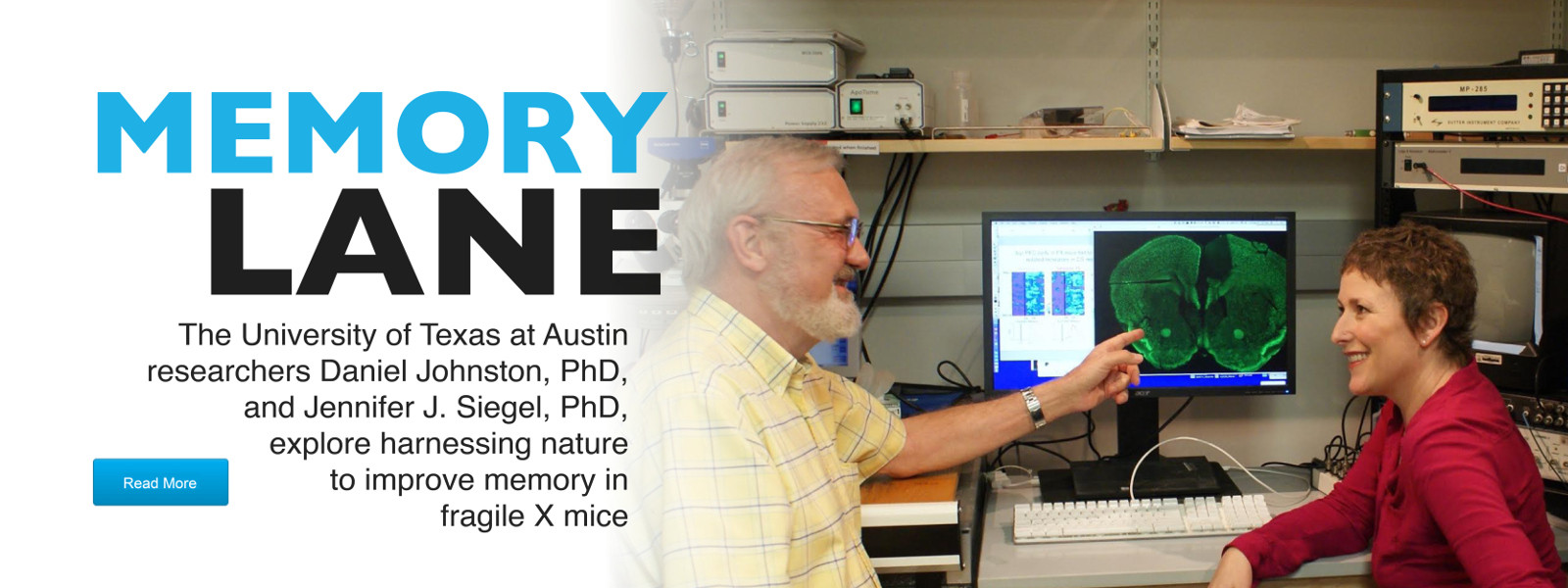
The University of Texas at Austin Researchers Daniel Johnston, PhD, and Jennifer J. Siegel, PhD, Explore Harnessing Nature to Improve Memory in Fragile X Mice
We all forget things at times.
How many times have you misplaced your car keys or forgotten the name of a person you just met?
Now think how you would feel if your memory was stunted from birth?
Researchers at The University of Texas at Austin know that people with Fragile X syndrome have working memory deficits because of a dysfunction with the front part of their brain.
What they recently discovered is how a network of neurons is able to, on occasion, compensate for the loss of FMRP (Fragile X mental retardation protein) to regain memory function.
A Different Approach
“We are taking a slightly different approach to treating and potentially curing Fragile X,” said Johnston, professor, Department of Neuroscience, College of Natural Sciences, and Director, Center for Learning & Memory, The University of Texas at Austin. “We are studying how a small proportion of Fragile X mice are able to overcome the dysfunction and learn. In this way, function can potentially be restored. If it is not realistic to fix the many neuronal differences observed in the absence of FMRP, perhaps letting nature tell us how a non-FMRP brain can be functional may be a promising approach for intervention.”
Johnston has been studying neural dysfunction at the single cell physiology level for many years. Siegel has been recording neurons in awake behaving animals for more than 15 years. Their natural collaboration is expected to accelerate progress toward achieving their goal of identifying compensatory mechanisms for working memory deficits in Fragile X mice.
Balancing Inhibition and Excitation in Autism and Fragile X
They expect their biggest obstacles will come after they have determined how an FMRP-negative network of neurons can compensate to become functional, when they investigate ways to induce that in non-learning Fragile X mice.
“A common underlying theme of Fragile X may be a general imbalance between the activity of excitatory and inhibitory neurons, which is suggested as a common theme underlying autism spectral disorders in general,” said Siegel, a postdoctoral associate in the Johnston Lab, Center for Learning & Memory, The University of Texas at Austin. “We observe an excitatory/inhibitory imbalance in the prefrontal cortex of Fragile X mice and are using it as our model system. It is possible that restoring this imbalance may not only restore prefrontal dysfunction, but may also restore function in other brain regions, which may have far reaching effects in the treatment of other autistic disorders.”
Johnston credits FRAXA funding to allow Siegel to dedicate herself “100 percent” to determining how to restore excitatory/inhibitory balance in an FMRP-negative network and regain function. Both are grateful to FRAXA for their support.
“The ability to now work full time to address this line of research will certainly propel the project forward at an accelerated pace,” Johnston said. “FRAXA’s support has had a galvanizing effect on our research initiative. We believe FRAXA’s willingness to think outside of the box will open new doors and increase the odds of finding a real cure.
“The possibility this research may have a real impact on treatment is personally invigorating. There is incredible promise of being treatable if the right tools and approaches are taken.”
Written by
Theodore Coutilish, MA
FRAXA Board Member
Theodore Coutilish a distinguished leader in marketing communications, serves as the Assistant Director of Strategic Engagement and Communications at the University of Michigan. Dedicated to advancing Fragile X research and awareness, he has long advocated for this cause, motivated by his son, Andrew, who has Fragile X syndrome. Residing in Grosse Pointe Shores, Michigan, with his wife, Mary Beth Langan, Theodore earned a BA in Print Journalism from Wayne State University and an MA in Communications from the University of Detroit Mercy.


